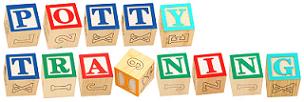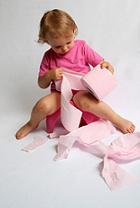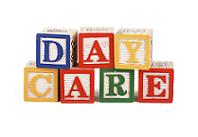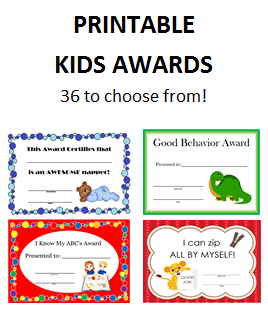Daycare Potty Training
Tips to Make the Process Easier
Before potty training can begin:
There are several things you can do before attempting any toilet training to make the process easier. As a mother of five and day care provider to many others, I've certainly done my share of potty training. I've discovered a few things that work.

How to Begin:
Use appropriate words to describe what is happening. (ex. "Oh, did you pee (or poop) in your diaper?") Use words you are comfortable with. Try to avoid words like "stinky" or "dirty" that can promote a negative feeling for children.
By the age of two, diapers should be changed in the bathroom. This helps the child to associate the room with what is in the diaper.
Talk about the benefits of being trained. How clean and dry feels better than wet or messy.
Find children’s' books about kids being trained to read to the child.
Have a potty chair the child can see and sit on. Even if they are sitting on it fully clothed it helps them to become familiar with it.
Potty Training
Is a child ready for toilet training? If you watch for the signs, the whole process of toilet training becomes easier. Typically a child will be showing signs of being ready between 24 and 30 months of age. Of course, since all children develop at different rates, some will be ready sooner, and others later. First and foremost, the child has to be ready. By ready, I mean the child has to show some interest in becoming trained.
There are several signs to look for:
- Can they communicate that they have to go..... before it happens?
- Does the child know appropriate words to describe what is happening?
- Can they pull elastic waist pants up and down by themselves?
- Are they showing a need to imitate others?
- Are they uncomfortable in wet or soiled diapers?
A combination of these things shows a child is ready.
Remember that any child who is experiencing stress is not a good candidate for toilet training. Wait until things are calmer. Never pressure a child who does not seem interested, or shame them in any way if they are not immediately successful.

Daycare Potty Training:
This should be discussed with the parents in advance. Let them know if you have noticed their child showing readiness. Parents will have their own views on how the process should work. Follow their wishes.
Some parents use the reward system, others choose not to. Some parents use pull-ups, others believe a child should go straight to undies. I personally prefer the old-school way of using the 5-ply thicker undies. Unlike pull-ups the child feels wetness right away (and clean up is still easier than regular undies). Some parents believe a child should have a little potty chair, others feel a seat that fits on the regular toilet is a better system.
Regardless of which way the parents prefer, make sure that everything is handled at home and in daycare the same way. Use the same words to describe the bodily functions as the parents use. Easy to remove clothes should be worn both at daycare and at home. Any reward system must be consistent in both places. Making everything similar is much less confusing for the child and will make the whole process of potty training much easier.
Start Slowly...
Start slowly, perhaps by taking the child to the toilet once a day. After a few days, take them 2-3 times during the day. Ask periodically during the day if they have to go. The best way I have found is to keep the whole process pretty low key. Children who are ready are generally eager to please you and get it right. Rewards can be offered for using the potty chair. Sometimes this will result in a child running in the bathroom several times a day to eek out 2 drops of pee. It's all part of the learning process and typically doesn't last long.
Usually the process from beginning to end takes a few months.
In my experiences, boys take longer to train than girls. It's best to just leave boys alone until they are clearly ready. I have four sons and one daughter. My daughter is the youngest, so I had trained my boys and several day care children prior to her. The boys were trained between the ages of 2 1/2 and 3 1/2.
I bought my daughter a potty chair and pretty underwear a few days before her second birthday. I saw it as preparation for later when she was ready. She had shown only slight interest. She, however, saw the colorful lacy underwear as something she wanted NOW. I actually tried to talk her out of the whole thing, stating they were for her when she was "a little bigger". In my own mind, that meant after she had mastered the 5-ply type. She couldn't be convinced and we took off the diaper and put on the lacy panties. From that moment on, she was trained night and day. I never even had to ask her if she had to go, she told ME. It seems to be holding, she's 22 now, and still going strong.
I've helped train other girls since then, none of whom were trained that easily. They have however, generally speaking, been easier to train than the boys. It just goes to show, however, that if you wait until the child is truly ready, the whole potty training process can be very easy.
Special note for boys:
At some point in the training process, boys will want to try standing up. Use ringed cereal in the toilet bowl to give them something to aim for. It helps to create focus. Look out though, on occasion, they will turn to talk to you and a stream of pee will turn with them.
The potty training experience should be a positive one. Make sure the child knows you are pleased with their progress.
_________________________________________________________________

More Articles:
- Advice to New Providers
- Developmental Stages of Children
- Making a Child’s First Day Go Smoothly
- All About Circle Time
- Guidance (a better word than discipline) Issues
- Keeping Daycare Parents Happy
- Helping with Self-Esteem
- Cooking with Children
- Pets in Daycare
- Volunteering with Kids
_________________________________________________________________

Fun Activities for Kids
- Tooth Fairy Envelope and Award
- Crayon/Marker Art Activities
- Field Trip Ideas
- Bubble Activities
- Butterfly Craft
- Group Art Projects
_________________________________________________________________
from potty training to daycare tips
from potty training to simply daycare home
















